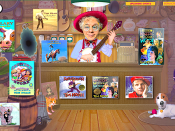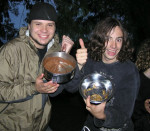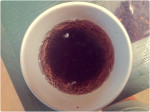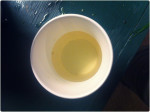
All of us have eaten insects, whether we knew it or not. As a kid, I even ate a worm on the playground to impress and gross out my friends. It’s not really a big deal. Unfortunately, adults who spent their whole lives growing up in western culture, now consider the notion of eating insects nothing short of repulsive. The truth of the matter is, insects have be an integral part of the food chain for millions of years, and as the United Nations just reported, we should start eating insects to fight world hunger, and as Wolf College’s Kim Chisholm describes, farmers should feed insects to their poultry and fish.
To this day, many cultures around the world still cherish insects as an irreplaceable food source, which is a far cry from the western anti-bug stigma. Adults in western culture may find bugs as filthy, gross, and socially unacceptable as a food source. Young children on the other hand, often find eating insects as perfectly natural, before the long arm of society pounds it out of them. With a little thought and determination, you too can break down your societal conditioning and enjoy one of natures healthiest foods!
Health Risks of Eating Insects
If you are still reading this:) you may be open to the idea of eating insects, so where should you start? First, learn about the many types of edible insects: ants, termites, grubs, beetles, worms, crickets/grasshoppers, mealworms, bees/wasps, spiders/scorpions, snails/slugs, and more. But before you go running off in search of the nearest insect, there are a few things to take into consideration: Not all insects are edible, and some contain toxins or parasites that can be harmful to humans.
As a general rule of thumb, avoid bright and obnoxiously colored insects. More times than not, bright, vibrant colors are a signal to predators that you don’t want to ingest them because more than likely, they’re toxic. The best eating insects tend to be colored very dull and easily camouflaged colors so they can avoid predators. Of course, when in doubt, stay on the safe side and don’t eat it.
Another thing to consider is the risk of parasites. Many insects, especially grasshoppers and crickets, as well as earthworms, have a tendency to carry parasitic nematodes such as tape and rag worms. Because of this, I highly recommend fully cooking any and all insects to mitigate your risk of contracting parasites.
Edible Bugs

As a world traveler and avid outdoors-man, survivalist, and a working culinary professional, I’ve eaten countless bugs in my days. The following are my experiences with insects and how they’re traditionally prepared and enjoyed.
- Ants: Ants come in all shapes and sizes, and all of them are edible. In general, the main species that are targeted as food are the big ones. Huge ants in the amazon are often toasted and eaten like peanuts. In Washington state, I’ve eaten many red thatching ants raw. They have a lemony acidic flavor to them and are usually pleasant, so long as you can avoid them biting your tongue.
- Termites: Much like ants, termites live in huge social colonies. They may be small, but in a colony, they can provide quite a bit of food. Termites are eaten all through Africa and Australia. I think they taste fairly good and nutty when toasted in a pan.
- Grubs: Grubs are usually the larva of beetles and other winged insects. They can often be found in dead/punky wood. They can be eaten raw or cooked, but are much better cooked. Most grubs have a tendency to be bitter before they’re cooked.
- Mealworms: Technically they can be considered a grub, but they deserve an honorable mention. Mealworms can be easily obtained at pet stores or from farms that sell online. The ease with which they can be obtained combined with their mild nutty flavor makes them the perfect choice for beginning insect eaters. They taste just like a nestle crunch bar when toasted in a pan and dipped in melted chocolate.
- Beetles: Some species of beetles are indeed edible, tho a large portion of them are brightly colored and are potentially toxic. Even the edible ones have a tendency to be extremely bitter and distasteful however. They’re not anywhere near the top of my list for best eating bug.
- Worms: Earth worms in particular are very high in protein. The main concern with earthworms is parasites, so be sure to cook them before ingesting them.
- Crickets/Grasshoppers: Crickets and grasshoppers are a delicacy in many places, especially mexico where they are often fried with chili powder, garlic, and lime juice. They’re sold as street food in many parts of mexico and I thoroughly enjoyed them on my many trips there. They also have a high risk of parasites though, so always cook them through.
- Bees/Wasps: While I personally have never eaten them, bees and wasps are eaten in many parts of asia, including China and Japan. They are usually deep fried in a sweet sauce and eaten with rice or noodles.
- Spiders/Scorpions: While not technically insects, many people consider them bugs. Tarantula’s in particular are eaten all over southeast asia as well as the amazon basin in south america. When i visited Cambodia in southeast asia, I ate tarantulas that were gathered in the rice patties and deep fried in a crunchy sweet batter. The flavor was hard to describe but fairly enjoyable. Scorpions can also be eaten so long as you are careful not to get stung. They are usually best deep fried or roasted over a fire.
- Snails/Slugs: Snails and slugs are notorious carriers of pathogens and parasites and require processing to be considered safe for consumption. When I prepared and ate slugs, first I had to gut them which resulted in my hands being coated in a thick slime that took days to come off. Then I ended up charring them over a fire until they tasted like burnt bacon. the amount of meat you get per slug isn’t anywhere near the effort. However, special snails are eaten as escargot. They are usually oven-roasted in garlic butter sauce and can be quite pleasant when done properly. Usually the snails need to be fed lettuce for a few days to make sure they haven’t ingested anything harmful to humans.

The author (right) and his sidekick whipping up chocolate covered mealworms in 2010.
Hopefully this information helps you get out and try insects for yourself. Who knows? You might even like them!
Charles Borrowman is a graduate of the French Culinary Institute of San Jose, California and a lead instructor with Wolf Camp and the Wolf College.
For In-Depth Learning, Join Our Weekly Online Classes:
- Tuesday Classes focus on Herbal Medicine & Plant Crafts in the autumn season, followed by Gardening & Cooking Wild Edible Food Plants in the spring.
- Thursday Classes focus on Wilderness Survival & Bushcraft Skills in the Autumn Season, followed by Wildlife Tracking & Birding in the spring.
- Saturday Classes for all ages guide you through the Wolf Journey Earth Conservation Course – Book One: The Neighborhood Naturalist.














I would like to know if you can eat lawn grub’s alive and raw I have been looking at the grub information online and they look like a delicacy but it would be my first time ever eating them
Thank you
James Maxson
P.S. I find them all the time in my soil
Hi James. Lawn grubs could be from many species. Try uploading a photo and description to iNaturalist to identify the grub species, then research edible qualities of what you have there. Also be sure there haven’t been any chemicals put on the area you find them. Take care and good luck.